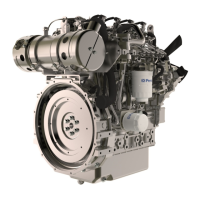Most conventional antifreezes use ethylene glycol.
Propylene glycol may also be used. In a 1:1 mixture
with water, ethylene and propylene glycol provide
similar protection against freezing and boiling. Refer
to Table 13 and refer to table 14 .
Table 13
Ethylene Glycol
Concentration Freeze Protection
50 Percent
−36 °C (−33 °F)
60 Percent
−51 °C (−60 °F)
NOTICE
Do not use propylene glycol in concentrations that
exceed 50 percent glycol because of the reduced
heat transfer capability of propylene glycol. Use ethyl-
ene glycol in conditions that require additional protec-
tion against boiling or freezing.
Table 14
Propylene Glycol
Concentration Freeze Protection
50 Percent
−29 °C (−20 °F)
To check the concentration of glycol in the coolant,
measure the specific gravity of the coolant.
Coolant Recommendations
• ELC Extended Life Coolant
• SCA Supplement Coolant Additive
• ASTM American Society for Testing and
Materials
The following two coolants are used in Perkins diesel
engines:
Preferred – Perkins ELC
Acceptable – A commercial heavy-duty antifreeze
that meets “ASTM D6210” specifications
NOTICE
The Perkins industrial engines must be operated
with a 1:1 mixture of water and glycol. This con-
centration allows the NOx reduction system to
operate correctly at high ambient temperatures.
NOTICE
Do not use a commercial coolant/antifreeze that only
meets the ASTM D3306 specification. This type of
coolant/antifreeze is made for light automotive
applications.
Perkins recommends a 1:1 mixture of water and
glycol. This mixture of water and glycol will provide
optimum heavy-duty performance as an antifreeze.
This ratio may be increased to 1:2 water to glycol if
extra freezing protection is required.
A mixture of SCA inhibitor and water is acceptable
but will not give the same level of corrosion, boiling
and, freezing protection as ELC. Perkins
recommends a 6 percent to 8 percent concentration
of SCA in those cooling systems. Distilled water or
deionized water is preferred.
Table 15
Coolant Service Life
Coolant Type
Service Life
(1)
Perkins ELC
6,000 Service Hours or Three
Years
Commercial Heavy-Duty Anti-
freeze that meets “ASTM
D6210”
3000 Service Hours or Two Year
Commercial SCA inhibitor and
Water
3000 Service Hours or One Year
(1)
Use the interval that occurs first. The cooling system must also
be flushed out at this time.
ELC
Perkins provides ELC for use in the following
applications:
• Heavy-duty spark ignited gas engines
• Heavy-duty diesel engines
• Automotive applications
The anti-corrosion package for ELC is different from
the anti-corrosion package for other coolants. ELC is
an ethylene glycol base coolant. However, ELC
contains organic corrosion inhibitors and antifoam
agents with low amounts of nitrite. Perkins ELC has
been formulated with the correct amount of these
additives to provide superior corrosion protection for
all metals in engine cooling systems.
ELC is available in a premixed cooling solution with
distilled water. ELC is a 1:1 mixture. The Premixed
ELC provides freeze protection to −36 °C (−33 °F).
The Premixed ELC is recommended for the initial fill
of the cooling system. The Premixed ELC is also
recommended for topping off the cooling system.
SEBU9075-03
69
Maintenance Section
Fluid Recommendations

